Introduction
An analysis that was conducted about ten years ago regarding the world’s most populous cities and their vulnerabilities to major natural hazards came up with findings that paint a bleak future for these cities. The study, cited in Taubencock, Roth and Dech (2008), assessed the status of 100 most populated cities in the world. The analysis found that 78 percent of these cities were at risk of being affected by one out of four chief natural hazards that had been identified (Taubencock et al 2008). The four major catastrophes included earthquakes, tsunamis, volcanoes and lastly, windstorms such as tornadoes (Taubencock et al 2008). It is important to note that flooding, which is also a major natural catastrophe, was not included in this analysis. The picture might have been even grimmer if flooding was included.
Forty five percent of those cities analysed were exposed to more than one of these hazards. The study went further to state that the situation is even worse in the developing nations than in the developed ones. In the former, 86 percent of the cities were exposed to more than one of these catastrophes (Taubencock et al 2008).
It is noted that nature herself is not the cause of the natural disasters that are experienced in several parts of the world, disasters such as flooding and the accompanying loss of lives and destruction of property. This is despite the fact that the event that led to this disaster might have emanated from nature herself. What this means is that there is a difference between natural hazard and risk on one hand and natural disaster on the other. Natural hazard are the events or risks that emanate from nature and which are beyond the control of man. On the other hand, natural disaster is the loss of lives and destruction to property that emanates from this hazard, but which man can control.
The risks, destruction of property and loss of life emanating from nature can be conceptualised as the outcome of the dynamics of the systems in existence in the society. For example, the natural disasters in the urban area are the result of the dynamics of the cities system (Taubencock et al 2008). The interplay between the various aspects of the urban system is responsible for the destruction and loss of lives. This is for example the feedback loops, ideas and policies adopted by the urban planners and authorities among others.
This means that the loss of lives and destruction of property that emanates from the natural disasters such as windstorms and volcanoes can be averted. In a nutshell, the occurrence of the natural disaster such as the volcano cannot be averted, but the destruction that it causes can be. This can be achieved through adoption of policies such as restriction of buildings along areas vulnerable to volcanoes, building of structures that can withstand the damaging effects of storms and such other measures. This will greatly reduce the loss of lives and destruction that is brought about by the natural catastrophes.
As already noted, earthquake is one of the major natural catastrophes that leads to loss of lives and property in the world today. According to Erdik (2009), several earthquakes with ranging intensity do take place in various parts of the world in any given year. Some of them occur in isolated places such in the wilderness, where the only destruction that they cause is the loss of lives of several wild animals and panic among the same. In other places such as in the oceans, the effects of earthquakes on the floor of the ocean lead to tsunamis and panic among the creatures of the sea. In such cases, such earthquakes are so removed from the human society such that they might go unnoticed by majority of the people apart from the experts who keep track of them.
Other earthquakes, according to Rebekah (2005), are so minor such that the tremors are not discerned by the people living where they did occur. This is especially so if the earthquake measured less than 2.0 in the Richter scale (Rebekah 2005). Again, such tremors are only discernible to the experts who keep track of such developments using seismograph technology.
However, there are other forms of earthquakes that cannot go unnoticed in the society. This is given the impact that the tremors have on those living along the epicentre and the surrounding areas. Such tremors destroy properties such as buildings, bridges and may also lead to loss of lives.
Several factors inform the level of destruction that comes with the earthquake. For example, the status of the buildings may affect the level of damage that is visited on them. The population density on the areas affected equally affects the number of casualties, as well as the efficacy of the response team that comes to the rescue of the casualties.
One of the major impacts that earthquakes have on the society, especially in the urban areas, has to do with the destruction that it metes out on the buildings and other structures in the area. Poorly designed and constructed buildings rarely survive the impact of the tremors, and this may lead to loss of lives if the buildings were occupied.
It is as a result of this realisation that architects, designers, engineers and other players in the building industry have come together to brainstorm and come up with designs that are resistant to the effects of the earthquakes. The so called seismic designs in architecture are designed in such a way that the building or structure can withstand the tremors of the earthquake.
Seismic design has been incorporated in the construction of structures especially in areas that are prone to earthquakes in the world. These are areas that lie along unstable tectonic plates, tectonic plates that are in a constant shifting position. Turkey is such one area in the European part of the world.
This dissertation is going to look at the benefits that modern technology has had on new seismic design techniques in Turkish architecture. This author is alive to the fact that architectures and engineers in this part of the world has incorporated modern technology in their designs such that the buildings and structures that come up in this earthquake region are resistant to the effects of the tremors.
This paper will cover several theories that are to be found within this field. The paper will also address the issue of earthquakes in Turkey and the vulnerability of this region to the catastrophe. The author will use several case studies of buildings in Turkey that have been designed in such a way that they are resistant to the effects of earthquakes.
Background Information
The phenomenon earthquake has been defined variously by different players in this field. The definitions reflect the philosophies of the scholars and their professional and other interests that they have in the field. But a definition by Tobriner (2008) seems to sum up the various conceptualisations into a working definition. This scholar defines an earthquake as the outcomes of a sudden emission or release of energy in the crust of the earth (Tobriner 2008). This release of energy results in the creation of seismic waves, and it is these waves that are felt on the surface of the earth.
Different areas around the world experience differing frequencies, types and magnitudes of earthquakes at any given time. This is what Erdik (2009) refers to as the seismicity of that particular region, or the seismic activity of the same. The earthquake that takes place in any part of the world is measured using the seismograph, a device that is calibrated in such a way that even the tiniest of the earth crust’s tremors can be detected.
As earlier indicated, although earthquakes that are below the 3 mark on the Richter scale are detected and reported using the seismograph, the same are mostly imperceptible to the humans living above the surface of the earth. However, those with magnitude ranging from 7 on the Richter scale can cause serious damage to humans and to the properties on areas within and around the epicentre (Bachmann 2003).
Analysts are of the view that Turkey is one of the countries in the world that has suffered great losses due to earthquakes. A lot of lives have been lost and property destroyed due to frequent earthquakes for many centuries (Bodew 2010).
Statistics show that in the twentieth century alone, more than 110,000 people lost their lives in this country due to earthquakes (Lang, Ende and Schwarz 2004). Within the same span of time, more than a quarter of a million of people in this country were hospitalised with ranging injuries, again from the earthquakes. Structures and buildings were not spared by the catastrophe, and Bodew (2010) is of the view that estimates put the number of housing units that were destroyed during this period at 600,000.
But perhaps the earthquake that acted as a waking up call to the government and other agencies involved in the construction industry is the one that took place in the year 1999. In this year alone, two major quakes shook the industrial city of Izmit and parts of Istanbul. As a result of these, it was realised that an extensive and detailed response system was needed in the country to safeguard against the effects of earthquakes in the future. This is especially so after earthquake experts predicted that the city of Istanbul will be the target of a major earthquake in the near future. The detailed planning for such eventualities, according to Bodew (2010), should be based on an extensive risk analysis of potential seismic hazards in the country. This is especially so around and within the city of Istanbul.
Erdik (2009) is of the view that the risk of disasters emanating from earthquakes in this country’s urban centres has risen in the past few decades. This can be attributed to several factors such as high rates of urbanisation. Other factors are such as inappropriate use of the land accompanied by poor planning of structures and constructions (Erdik 2009). Inadequate and poor infrastructure, together with environmental degradation, has also aggravated the situation.
The significance of the risk that this country faces as a result of this can be appreciated by the findings of comparative studies that have been conducted in other parts of the world. For example, studies have shown that California, which shares the same level of earthquake hazard as Turkey, has lower vulnerability of building stock than Turkey (Lang et al 2004).
Lang et al (2004) attribute this high level of vulnerability to several factors both within and without the control of the authorities in this country. One of them is the poor quality of the residential houses as far as their construction is concerned. Another is the high rates of inflation that makes it hard to construct strong houses and high rate of urbanisation. Poor supervision of the construction designs in this country together with endemic lack of accountability in the construction industry is other contributing factors.
It is as a result of this realisation that architects and engineers in this country have integrated modern technology in the seismic designs used in the construction industry in this country. This is evidenced by the increasing numbers of modern buildings that are cropping up in this country, buildings that are resistant to the effects of earthquakes. A case in point is the ultra modern Istanbul Airport, an architectural masterpiece that is touted as the biggest earthquake proof building in the entire world (Bodew 2010).
Objectives of the Study
Objectives of any study can be conceptualised as the goals that the researcher intends to attain by the findings of the current study. There are major objectives and specific objectives. The major objective is the main goal around which the study revolves. The major objective is addressed by the successful attainment of the specific objectives.
Major Objective
The major objective of this study is to look at the benefits that modern technology has had on seismic design techniques in Turkish architecture.
Specific Objectives
This study will have several specific objectives. These are as outlined below:
- An analysis of earthquakes in Turkey
- Analysing the link between modern technology and seismic designs in Turkish architecture
- Analysing the link between earthquakes and architecture in Turkey
- The development of seismic designs in Turkey
- Case studies of earthquake proof buildings in Turkey
Research Questions
Every study has questions that the researcher aspires to answer by the findings of the study they are conducting. Research questions act as sign posts that guide and direct the study, and they are always at the back of the researcher’s mind throughout the study.
This study is no different, and the following are the research questions that the researcher will be aspiring to answer in this study:
- What are some of the reasons that make Turkey vulnerable to earthquakes?
- What are some of the responses that designers and engineers in Turkey adopted towards earthquakes in the country?
- What are some of the technological innovations that have been incorporated into architectural designs in Turkey?
- What are some of the benefits that modern technology has had on seismic designs in Turkish architecture?
- What are some of the earthquake proof buildings in Turkey?
Significance of the Study
There are many studies that are being conducted at any given field at any given time. This being the case, it becomes important for a researcher to justify the study that they are currently conducting. The new knowledge that the current study is going to add to the field will justify it. This is the quality and quantity of the new information that the study is going to add to the field.
The findings of this study will help policy makers in Turkey to realise how modern technology has benefited seismic design techniques in this country. With this information, players in the architectural industry will be able to integrate modern technology in their designs. This is important since it will reduce the destruction to property and loss of lives as a result of earthquakes in the future. This is especially so given the fact that earthquake experts has predicted that a major quake is going to occur around Istanbul in the near future. As a result of this, it is important to be prepared in order to reduce the number of casualties and destruction to property should this happen.
Scope and Limitations
The following are the scopes and limitations for this study:
- The study is going to focus on earthquakes in Turkey only. This is despite the fact that there are other countries and regions that are vulnerable to this catastrophe
- The study is going to look at earthquakes in this country within the context of architecture. The link between earthquakes and other aspects such as economic loss will not be addressed
- The study will be limited to earthquakes as natural hazards. This is despite the fact that other natural hazards such as floods are also significant to the architecture industry
Structure of the Paper
This paper began with the introduction chapter, which highlights the major issues that will be covered in the paper. This will be followed by the second chapter, which will be literature review. This chapter will analyse relevant literature in the field, and the link between this and the current study. The third chapter will involve an analysis of case studies where earthquake proof buildings in the country will be reviewed. The conclusion chapter will summarise the major highlights of the paper, and this will include the thoughts of the author regarding the chapter.
Summary
This chapter introduced the study to the reader. The major aspects that the paper will cover were provided. The aim of this paper was to provide the reader with an idea of what the study will involve. This will prepare the reader to face the rest of the paper.
Literature Review
Introduction
The previous chapter introduced the reader to the study that is going to be conducted. The chapter provided the reader with the structure of the paper, the research questions to be answered among other highlights of the paper.
This chapter will involve a review of current literature in this field. The link between this literature and the current study will be analysed. This will help in contextualising this study within the larger field of earthquakes and architecture in the Turkey.
It is to be noted the benefits of any new study in a given field is judged by the amount and quality of knowledge that it adds to the field. Review of literature in the field makes the researcher to be aware of studies that have been conducted in the field in the past and the findings of the same. As such, the researcher avoids duplicating studies that have been conducted in the past.
Occurrence of Earthquakes on the Surface of the Earth
Naturally occurring earthquakes, which are also referred to as tectonic earthquakes, can take place anywhere on the surface of the earth provided some criteria are met. This is the presence of adequate and pent up elastic strain energy that is used to move fracture propagation along a fault plane (Celik, Sesigu and Cili 2006).
A large portion of the earth’s fault surface is made up of a transform or convergent form of plate boundary (Wada and Mori 2009). These plates constantly move past each other or towards each other, and this can take place smoothly and aseismically (Wada and Mori 2009). But this occurs in the absence of asperities or what Bachmann (2003) refers to as asperities. When these irregularities occur along the plates’ boundaries, they raise the friction energy that tends to occur there.
Majority of the convergent boundaries have irregularities, and this gives rise to a stick-slip movement along the boundaries (Tobriner 2008). The boundary locks together, and additional motion between the plates increases the stress along the fault line. A lot of energy is produced and it is stored around the fault surface (Taskin, Guler and Altan 2010). When the stress energy has risen to sufficient levels, it leads to a break through the irregularity. This makes the plates to slide over each other and over the locked part of the fault, and this releases the pent up energy (Taskin et al 2010).
The release of this pent up energy is what leads to earthquake. This theory of occurrence of earthquake is referred to as the elastic rebound theory (Erdik 2009). This theory goes ahead to state that it is only about a tenth of the total energy of the earthquake that is emitted as seismic energy (Tobriner 2008). The rest of the energy is converted into heat or is used to move the plates over each other.
Earthquakes in Turkey
This country has experienced a number of major earthquakes throughout its history. This is given the fact that the country is located on the Eurasian geological plate, a plate that is described by experts in the geological field as one of the most active on the surface of the earth (Wada and Mori 2009).
The earliest known earthquake to have occurred in this country, and which is recorded in the country’s history books, occurred in the year 411 BC (Celik et al 2006). From that time, more than 100 earthquakes have been recorded here, all with magnitudes of 7.0 and more. If those earthquakes with less than 7.0 magnitude are taken into consideration, the picture changes drastically as the number might be more than 100 (Tobriner 2008). According to Celik et al (2006), at least 14 earthquakes have taken place since the year 342 AD, all leading to deaths and injuries of more than 10,000 people.
This country is also located on the border of the Arabian, African and Eurasian plates. These plates are constantly moving towards each other or pulling away from one another, creating a very unstable region in this area (Wada and Mori 2009).
The North Anatolian fault is one of the fault lines that have arisen from the interaction between these tectonic plates (Tobriner 2008). This fault occupies most of the northern part of what Taskin et al (2010) refers to as the Asian minor. The unstable nature of this fault line makes this region and Turkey as a whole to be regarded as one of the most seismically active areas in the whole of the world (Carayannis 2000). The figure below is an indication of this fault line:
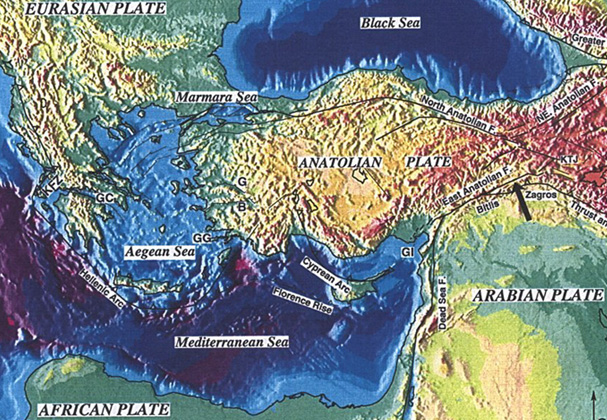
Most of the earthquakes that have occurred in Turkey have taken place along this fault line. It covers an area of about 1200 kilometres from east to west of the country (Carayannis 2000). According to Wada and Mori (2009), this fault line is a product of the Eurasian plate moving against the Anatolian plate. Studies have been conducted in this area since the year 1930. Studies have come to the conclusion that the Turkish part of the fault line is pushing approximately three centimetres per year against the Greek part of the fault (Carayannis 2000).
The figure below depicts the movement of this fault line:

Modern Technology and Seismic Design of Buildings
Lang et al (2004) holds the view that advanced technology has enabled the development of seismic design technology in contemporary society. This has enabled engineers and architectures to come up with buildings that have ranging seismic safety levels addressing the needs of the different societies around the world.
It is noted that earthquakes strong enough to destroy buildings occur at intervals that may be longer than that of individual architectural structures or that of the members of the society. However, the life of the emerging urban centres is longer, making the seismic action stronger than the seismic designs that have been adopted (Wada and Mori 2009). This means that buildings that have been seismically designed for their life only are more vulnerable to damages caused by the earthquakes. This hampers the continuity of cities and other urban centres. This being the case, it is important to come up with seismic designs that will assure the continuity of urban centres beyond the individuals and buildings therein.
The integration of modern technology and seismic designs has led to a distinctive field in engineering that Bachmann (2003) refers to as earthquake engineering. This is the study of the reaction of buildings and structures when they are subjected to what Bachmann (2003) refer to as seismic loading. The major objective of this technology is to analyse the link between civil infrastructure and the ground above which they are located. This is together with the prediction of the vulnerability of buildings to earthquakes in those areas. This field also focuses on the designing and construction of structures that can withstand earthquakes and which at the same time adhere to the different building codes in various countries (Bachmann 2003).
Construction and Design Irregularities that May Cause Heavy Damage due to Earthquakes
Aesthetic or preferences usage of buildings may lead to irregularities either in the planning or elevation of the structure (Bodew 2010). Experts are of the view that structures that have weak and soft stories, especially in the urban centres, suffer from extensive damages or total collapse as a result of seismic activities (Taskin et al 2010). The following pictures vividly depict the effects of earthquake on weak storied buildings:
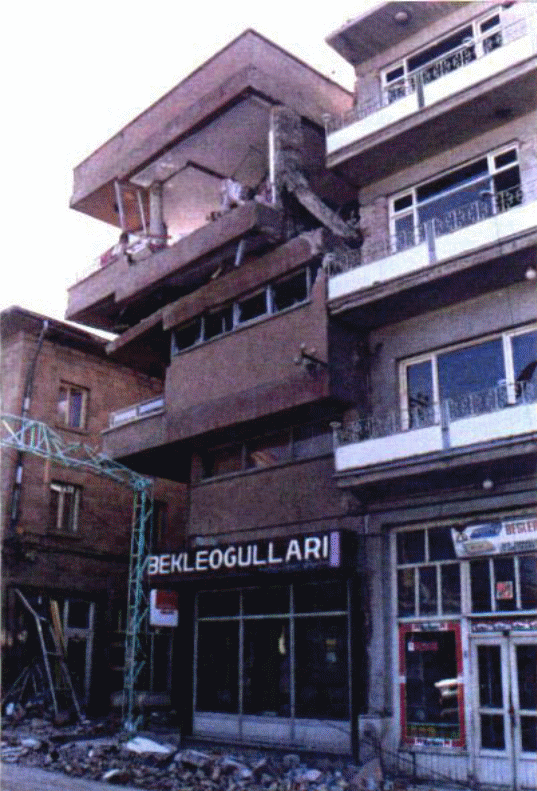
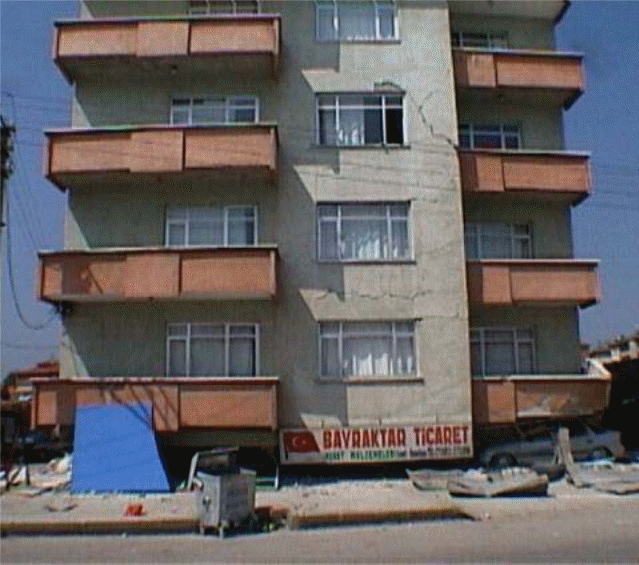
Another form of structural irregularity that may lead to high casualties during earthquakes is the discontinuity of lateral structural members that carry the weight of the structure (Taskin et al 2010). The figure below indicates this clearly:
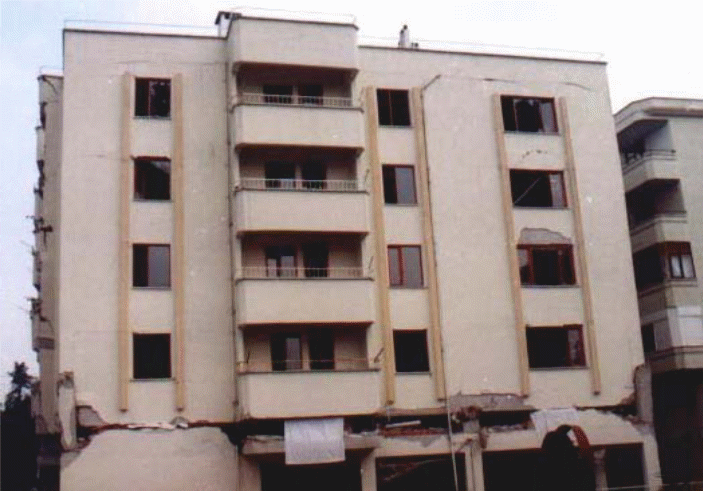
The above are just some of the irregularities that may lead to structural damages during earthquakes. Others are torsional irregularities, huge galleries in the structural system, extremely long and heavy cantilevers among others (Taskin et al 2010).
Modern Technology and Seismic Architectural Designs in Turkey: A Case Study of Retrofitting
According to BBC News (2010), cases of frequent earthquakes in Turkey in the recent past has prompted the authorities to come up with policies that are aimed at reducing the number of casualties and property damage that accompanies the same. One form of response is the retrofitting of new buildings and the already existing structures in Turkey.
Retrofitting
According Tobriner (2008), the major aim of retrofitting is to mitigate the vulnerability of buildings and structures in the case of an earthquake. This technology is aimed at protecting the structure itself and the inhabitants therein. The following are some of techniques that are used in retrofitting:
Unreinforced Masonry Walls
These walls are heavy and brittle, and they tend to collapse in the event of an earthquake. Retrofitting involves making these walls more resistant during earthquakes, such as they do not easily collapse.
Shear Walls
This is probably one of the best retrofitting options in seismic designs. Taskin et al (2010) are of the view that this form of retrofitting holds the best seismic track record amongst all the retrofitting techniques in modern architecture.
Other Retrofitting Techniques
There are other retrofitting techniques such as seismic isolation, masonry infill walls, braced frames and moment frames (Bachmann 2003). Tobriner (2008) is of the view that seismic designers in Turkey usually make use of concrete jacketing and steel members in retrofitting.
Chapter Summary
This chapter analysed literature that exists in the field of modern technology and seismic designs in architecture. The aim of the chapter was to make the researcher be aware of the studies that have been conducted in this field and the findings of the same. Some of the issues covered in this chapter include earthquakes in general and specifically in Turkey, irregularities in structural construction that may lead to damage of structures and loss of lives during earthquakes, seismic designs in Turkey among others.
The following chapter is going to look at some of the earthquake buildings in this country. The aim of the chapter will be to highlight to the reader the actual integration of modern technology and seismic designs in Turkey.
Case Studies
Introduction
In the previous chapter, the author reviewed and analysed the literature that exists in the field of modern technology and seismic designs in architecture. In this chapter, a case study of several earthquake resistant buildings in Turkey will be provided.
Istanbul Sabiha Gokcen International Airport
The designers of this building claim that it is the largest earthquake proof building in the world. Specifically, Arup, who are the brains behind this building, claims that it is the largest seismically isolated structure in the whole of the world (Bodew 2010).
According to Bodew (2010), about 7,000 construction workers were used as source of labour in this project. The terminal covers about 2 million square feet, and it does not sit directly on the soil (Bodew 2010).
The constructors instead used more than three hundred isolators on which the structure sits on. These, according to Erdik and Durukal (2008), are bearings that can assume a side to side motion in response to the seismic waves of an earthquake. The terminal has been structured in such a way that it moves as a single unit, a phenomenon that averts damages occurring from uneven forces of a structure that moves separately.
The construction of this structure was necessitated by the earthquake that took place in the year 1999. Thousands of people suffered from this earthquake, and a lot of property was damaged. The creation of this building was also informed by the predictions that were made by earthquake experts in this country. The experts are of the view that within the next thirty years, Istanbul is likely to suffer from another major earthquake.
The figures below are representations of isolators similar to those that are used in this project:
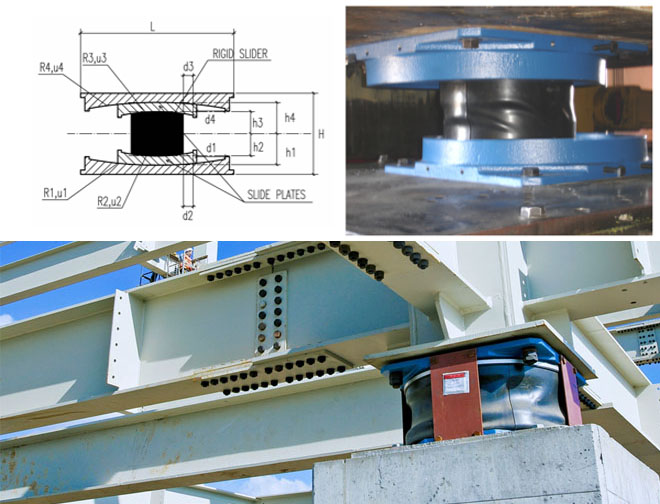
The terminal exceeds the American construction codes, and, according to Arup, it can withstand an earthquake of 8.0 magnitudes (Bodew 2010).
The figures below show the completed Turkish terminal as seen from above:
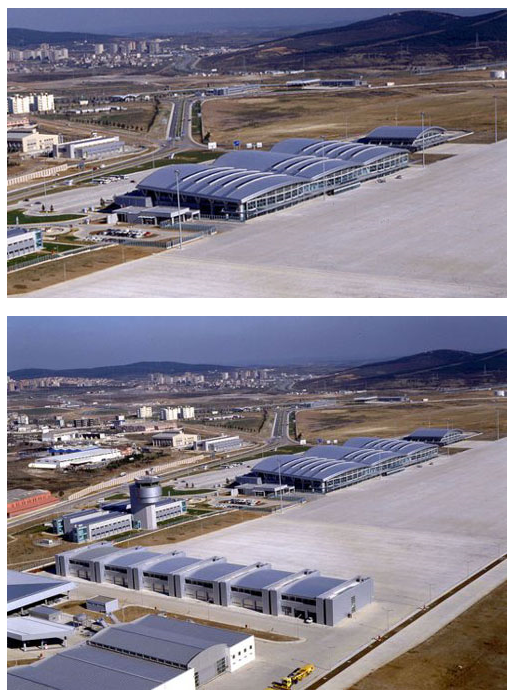
This building is considered by many to be a unique merge of contemporary and traditional technology in Middle East. According to Harvey (2008), the building sits on a dusty brown hillside that was a barren site before it was constructed. The construction is on the Asian side, about fifty kilometres from the city of Istanbul. It is accessible by the road that connects Europe and Ankara (Erdik and Durukal 2008).
This building is another masterpiece of earthquake proof building in the country. The building slopes on a southerly direction in a series of terraces (Erdik and Durukal 2008). It borders the Sea of Marmara, and it is the centre of the bank’s daily operations.
The building is divided into eight, three floor courtyard buildings that are linked to each other. The connection is done by a series of internal streets within the structure. The junctions of the internal streets, there are stairs towers and cylindrical vertical service lifts (Erdik and Durukal 2008). The single structures are 35 meters square and they contain courtyards within so that sunlight can stream into the work stations from the outside.
The division of the larger complex into single standing structures or buildings is a seismic design on itself (Harvey 2008). According to Tobriner (2008), a structure as big as Yapi Kredi Operations Centre, for it to be earthquake proof, should be able to move in discrete parts in response to seismic waves. The designers of the building, Ove Arup & Partners, is of the view that the separation of the structures makes it possible for the empty spaces between the structures takes up the movements brought about by the seismic waves of the earthquake.
If a large building such as the bank’s operations’ building was to be constructed as a single unit, a lot of damage could take place as a result of earthquakes. This is given that the huge structure will move as a single unit and the massive weight will make it cave in on itself. The figure below represents a section of the operations’ centre, showing the separate structures within the huge complex:

Chapter Summary
This chapter looked at several buildings that have been constructed in this country and that have been designed as earthquake resistant structures. The aim of this chapter was to introduce the reader to actual seismic designs in Turkey and to portray how modern technology has benefitted these designs. One of the case studies was the Turkey Istanbul airport, the terminal which is regarded as the biggest structure on seismic isolators. The second was the Yapi Kredi Operations Centre, which is another architectural masterpiece in this country.
The next chapter will be a conclusion of the whole paper. The main points that were covered in the whole paper will be summarised, and recommendations will be given where necessary.
Conclusion
Modern technology and design methods have been incorporated to provide various seismic designs in the construction of buildings in earthquake prone areas. These are areas such as Turkey, a country that sits at the confluence of three tectonic plates making it one of the most unstable regions in the world.
Innovations in structural design methods have also enabled architectures to come up with designs that perform highly in cases of seismic waves brought about by earthquakes. There are several goals that new seismic designs aim at achieving in the construction industry. This includes saving lives, retaining the functionality of structures in the aftermath of seismic action together with the reduction in the amount of damage that occurs after an earthquake hits a building.
Seismic designs are not limited to structures alone, but they extend to other aspects of the construction industry such as the aesthetics that are to be found within the buildings. Aesthetics such as decoration fixtures must also be earthquake proof if the building and the lives therein are to be protected from the vagaries of an earthquake.
However, there are several limitations that reduce the benefits that modern technology accrues to the seismic designs in the construction industry. This is for example the rise in costs as far as the technology is concerned. This is given the fact that materials and other form of expertise that is needed for this form of construction are costly.
This paper looked at the benefits that modern technology has on seismic designs in Turkish architecture. The author looked at earthquakes in general and specifically the vulnerability of Turkey to the same. The link between modern technologies was provided, especially through the two case studies that were given on chapter three.
References
Bachmann, H 2003. Seismic Conceptual Design of Buildings-Basic Principles for Engineers, Architects, Building Owners, and Authorities. Federal Department of Foreign Affairs.
BBC News 2010. Turkey Earthquake Prompts Homes Rethink. Web.
Bodew.com 2010. Biggest Istanbul Turkey Airport Earthquake Proof Building Design in the World. Web.
Carayannis, G P 2000. The Earthquake of 12 November 1999 in Turkey. Web.
Celik, O., Sesigu, H., and Cili, F 2006. Turkish Experience on Seismic Retrofit of Buildings using Steel Members. European Journal of Education, 2(3): 23-29.
Erdik, M 2009. Earthquake Vulnerability of Buildings and a Mitigation Strategy: Case of Istanbul. Web.
Erdik, M., and Durukal, E 2008. Damage to and Vulnerability of Industry in the 1999 Kocaeli, Turkey, Earthquake. Web.
Harvey, F 2008. Street Credit-Design of Yapi Kredi Operations Centre in Gebze, Turkey. Architectural Review: 45-49.
Lang, D H., Ende, C., and Schwarz, J 2004. Vulnerability of RC Frame Structures in Turkish Earthquake Regions (Part 1): Instrumental Testing. 13th World Conference on Earthquake Engineering, Vancouver, Canada.
Rebekah, G 2005. Research on Earthquake Vulnerability in Istanbul, Turkey. Web.
Taskin, B., Guler, K., and Altan, M 2010. Evaluation of the Role of Architectural Design in Earthquake Damages of RC Buildings. Web.
Taubencock, H., Roth, A., and Dech, S 2008. Vulnerability Assessment using Remote Sensing: The Earthquake Prone Mega-City Istanbul, Turkey. Web.
Tobriner, S. Wooden Architecture and Earthquakes in Turkey: A Reconnaissance Report and Contemporary on the Performance of Wooden Structures in the Turkish Earthquake 1999. University of California, Berkeley.
Wada, A., and Mori, N 2009, Advanced Seismic Design of Buildings for the Resilient City. Web.